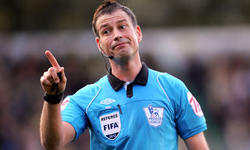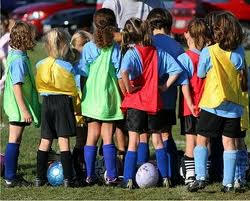| |

 |
TO MARK A... REFEREE or MARK A... TEAM
Andrew Castiglione
Founder of Ken Aston Referee Society

1. How Teams can mark the Referee from 1 to 10:
2. How the Referee can mark Teams from 10 to 1:
|
1. How Teams can mark the Referee from
1 to 10.
(Note, this marking system is meant to be mainly used when Club
Assistant Referees (or no Club Assistant Referees) are used. This
marking system can be used when neutral Assistant Referees are employed,
but the interaction between the Referee and the Assistant Referees will
need to be factored into the overall marking assessment.
Out of an overall mark of 10.
 - A total of 2 marks should be awarded for Appearance.
- A total of 2 marks should be awarded for Appearance.
 - A total of 3 marks should be awarded for Application
of the Laws: Including correctness of decisions, clear signals, good
positioning, fitness and advantage.
- A total of 3 marks should be awarded for Application
of the Laws: Including correctness of decisions, clear signals, good
positioning, fitness and advantage.
 - A total of 5 marks should be awarded for General
Control: Including, confidence, and impartiality, satisfactorily dealing
with major incidents.
- A total of 5 marks should be awarded for General
Control: Including, confidence, and impartiality, satisfactorily dealing
with major incidents.
Who in the team should decide the mark?
It is always better for the same person to award the mark each week, but
of course this is not always possible. It is recommended that the person
giving the marks should not to be one of the players or a Club Assistant
Referee.
How critical should the marker be?
Referees vary in qualification and experience - some games flow better
than others. The weather, type of venue and ground conditions can also
affect the game.
It may be that the Referee has made a mistake merely because his
impartial opinion of a particular incident is different from the way
others see it. The Referee has to make the actual decision and not
others! Even if eleven players on one team disagree with the Referee,
the other team will probably support him.
The Referee should be judged on the performance for the whole game, and
not based on one decision (usually in the last 5 minutes of the game!)
that you have gone against a team. Do not expect the Referee to give one
team preferential treatment - they won't. The Referee is there to ensure
that the Laws of the Game are complied with. The Referee will not
support one side any more than the other and will be officiating at the
best of their ability.
How can marks be awarded?
Try to set a standard that can be used throughout a season. Do not make
particular allowances for newly qualified Referees or Senior well-known
(or local) Referees, before allotting the mark. Do not assume that a
Referee has to be faultless to be awarded a high mark. Do not mark the
Referee 'up or down' because they were good or bad [in the marker's
opinion] the previous time that the same Referee officiated.
Why does the Referee need to be marked?
Referees' marks are closely scrutinized throughout the playing season to
ensure that proper standards are maintained. They also indicate to the
respective League Committees, those Referees who are capable of
officiating in the most important games. The Football Associations can
also use the marks when assessing a Referee's promotion potential.
How should the marks be given?
Marks should be awarded out of a maximum of TEN and a minimum of 1 per
game. The Referee should perhaps start with the maximum mark of 10, and
then points may be deducted for those areas where the Referee falls
short. The fact that a Referee turns up at the game in proper uniform,
should lead to a minimum of 2 marks. A mark of 1 only, is not
acceptable, unless the Referee appears with no uniform, and has no idea
'at all' about officiating a game of football.
The following areas of a Referee's performance can be
considering when calculating the mark.
APPEARANCE - PERSONALITY - PUNCTUALITY: The Referee's
appearance and personality usually has a direct bearing on their ability
to control the match. Did they arrive early enough to examine the field
of play? Was their uniform clean and smart? Was the Referee cheerful and
unruffled throughout the game? Did they treat the players with the
respect they deserve? Was the Referee treated in the same way? Did the
Referee appear to enjoy the game?
FITNESS AND POSITIONAL SENSE: Referees have to be fit
enough to keep up with play. Whilst it should be remembered that it is
impossible for a Referee to cover every possibility, the superior
Referees should always be close enough to incidents that might have
proved critical, such as 'flash points' or occurrences near the danger
areas (i.e. the goals).
SIGNALS - INCLUDING USE OF THE WHISTLE: Were the
Referee's hand and whistle signals clear and confident? Did the Referee
use the whistle well - varying the tone according to the need, in other
words, did the Referee get the message across to the players when the
whistle was blown? Did the players know exactly which team had been
awarded a free kick? Did the Referee acknowledge the signals given by
the Club Assistant Referee? Whether or not the Referee agreed or
disagreed with the Club Assistant Referees' decision should not affect
the marking. The Referee is the sole decider, and the Club Assistant
Referees are there to help him.
OVERALL CONTROL: Allow some leeway when making
allowances for differing styles of Refereeing. Individual Referees have
varying methods of maintaining control. Some Referees adopt very rigid
attitudes, while others might appear more relaxed and try and bond
closely with the players throughout the game. The Referee's duty is to
enable players to play within the Laws, and in doing so, the Referee may
need to issue cautions and deal with players being sent-off. Marking
should not be based on the number of cautions and sending-offs a Referee
has issued. Dealing with indiscipline from the players is an essential
facet of the Referee's control. Was the Referee in control and
completely impartial throughout the game? Did the Referee officiate the
game without being influenced by the players / spectators /managers /
coaches. Shouts from players and spectators are often correct, but the
Referee may have had already decided to award the free kick anyway. This
should not be seen as "being influenced" by the players or the crowd.
If the Referee makes a late decision, consider whether the Referee might
have been looking to play an 'advantage'. Indeed, was the Referee brave
enough to try and play 'advantage', and if so, were the players
instantly aware of the Referee's "Advantage Play On" shouts and hand
signals? Try and remember that when playing advantage, a good player can
make the Referee look good, whilst a bad player can make the Referee
look foolish.
Referees will only act on what they see, and therefore cannot act on
incidents they haven't seen. Try to understand however that the Referee
might have seen a particular incident from an entirely different
viewpoint to others watching the same game.
FINALLY IT NEEDS TO BE SAID THAT REFEREES ARE UNDER THE SAME SORT OF
PRESSURES AS THE PLAYERS BUT THEY DO ENJOY THE GAME JUST AS MUCH.
WITH A LITTLE MORE UNDERSTANDING ON BOTH SIDES, EVERYONE WILL BENEFIT.
2. How the Referee can mark Teams from
1 to 10
Sportsmanship marking (1 to 10) structure that a
Referee can give to each team.
10: Exemplary conduct by ALL members of the club, both
on and off the field of play.
9. Only minor problems with one or two team members.
General conduct excellent.
8. General conduct of the majority of the team members
was above average expectations, but some minor problems experienced
7. Although the vast majority of the team behaved well,
two or three members behaved in an unacceptable manner / or / the
majority of the team did not always behave in a sporting manner.
6. Many members of the team behaved in an unacceptable
manner before, during or after the match. They did not appear to always
respect the Referee or their opponents, and did not respect the
Referee’s decisions.
5. Unacceptable conduct of the team showing little
regard to the elements of fair play and causing the Referee unnecessary
problems.
4. The vast majority of the team acted in a manner that
took most of the enjoyment out of the match for all concerned, and
played throughout with scant regard to the opponents’ safety.
3. Lack of respect for all aspects of the game, serious
discipline problems within the team.
2. Extremely serious discipline problems. On this
display, the team does not deserve to benefit from playing organized
football.
1. Recommended for expulsion from the League due to
TOTAL
lack of discipline in this match.
|